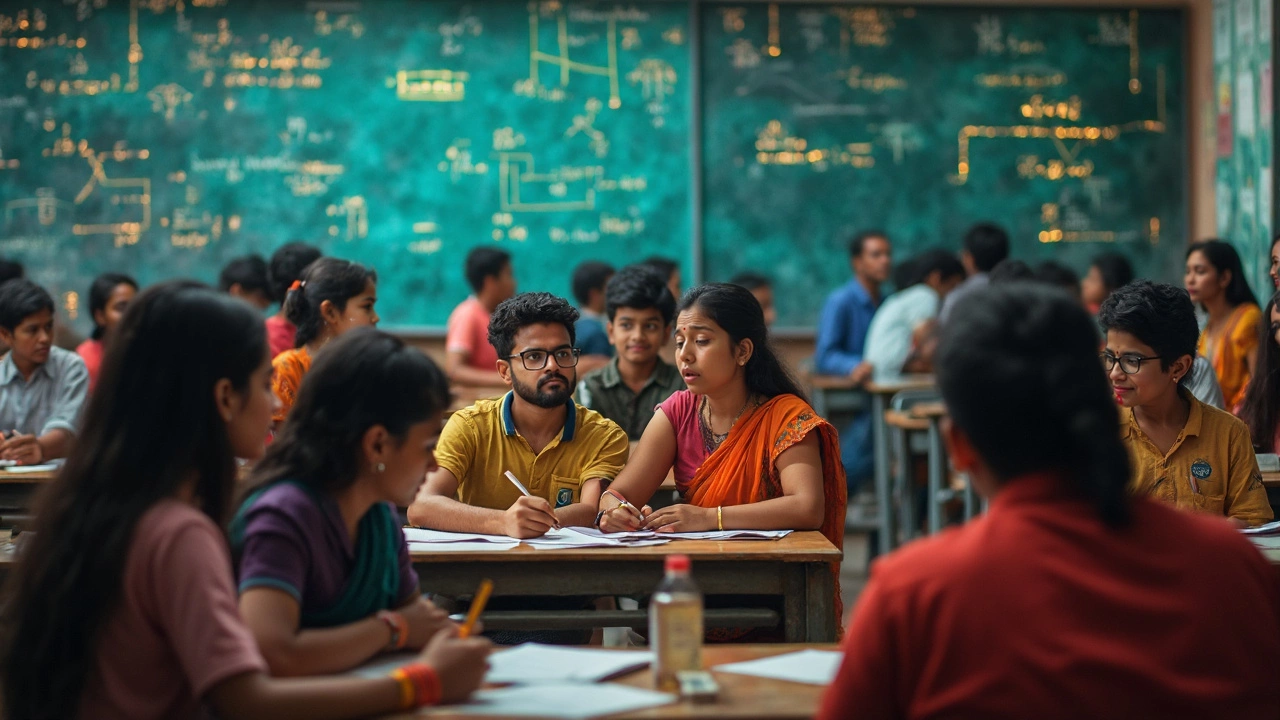Stuck on a math question that felt like it came from another planet? You're not alone—some math problems from big exams make even the smartest students sweat bullets. These aren't just your average word problems or quick calculations. We're talking about questions that show up in the IMO (International Mathematical Olympiad), Putnam, or India's JEE Advanced—stuff that's more like a brain boot camp than a test.
Here's the thing: The hardest math out there on these exams isn't just about knowing lots of formulas. It's about puzzles that twist your brain, require a creative leap, and sometimes make your books feel useless. Students remember these problems for years. They get shared online, debated, and even laughed about once the trauma wears off.
If you want to get better at handling these monsters, recognizing what sets them apart is a good first step. You don't need to be a math genius to appreciate how wild some of these questions get—but a game plan and a little grit can help you face them head-on.
- Defining the Hardest Math in Exams
- Legendary Problems and Their Stories
- What Makes a Question Brutal?
- How Top Problem-Solvers Prepare
- Tips for Tackling Impossible Math
Defining the Hardest Math in Exams
So, what exactly counts as the hardest math in competitive exams? It's not about the longest equation or the wildest numbers. The true monsters are those questions that combine logic, problem-solving, and creative thinking in a way that throws even the best-prepared students off.
Usually, you’ll find these toughies on math olympiads like the International Mathematical Olympiad (IMO), advanced college contests like the Putnam, and engineering or science entrance exams like India's JEE Advanced. For example, most Putnam participants actually score zero—just look at the data below. That’s how hard these questions get:
| Exam | Participants | Median Score | % with Zero Score |
|---|---|---|---|
| IMO | 600+ | 15/42 | Rare |
| Putnam | 3,000+ | 2/120 | 60% |
| JEE Advanced | 150,000+ | ~20% | Below 1% |
These aren't just hard—they're often designed so that only a tiny fraction of students get them right. It's part skill, part thinking-outside-the-box, and sometimes just pure stubbornness. The hardest math on earth in a test setting is usually the stuff that feels unsolvable at first glance but turns out to have a crazy slick trick once you see it.
If you were expecting just long division or a tricky quadratic, you're going to be surprised. One IMO gold medalist once said some problems took him days to solve, and others, he never could. That's the level we're dealing with.
- They rarely depend on memorized formulas—they want your brain to connect ideas.
- You often need to combine geometry, algebra, or number theory in weird new ways.
- Even top students bomb these unless they’re used to thinking under pressure.
The bottom line: If a whole room filled with math nerds sits stumped for hours, you know you’re facing something unforgettable.
Legendary Problems and Their Stories
Certain math problems from competitive exams get talked about years after the tests. These are the problems that force people to think sideways, and sometimes make the difference between first place and not even qualifying. If you ask around, any math nerd will name a few legendary questions that still haunt or inspire them.
The hardest math questions often come from the International Mathematical Olympiad (IMO). Take the 1988 IMO Problem 6. Most competitors just left it blank—it combined geometry and algebra in ways that didn’t fit normal patterns. Even top scorers struggled. Only 10 out of 300+ managed a perfect solution. It’s still used as a gold standard for difficulty.
Then there’s the 1995 Putnam Exam, where a seemingly normal problem about integer solutions had a twist that caught most students off guard. The average score on that whole test? Less than 2 points out of 120. That’s brutal.
JEE Advanced in India is famous for math questions that look simple until you realize there are a dozen concepts hiding inside. In 2011, a matrix question showed up that looked standard—turns out only about 2% of students answered it right. The rest lost a chunk of their precious time just trying to figure out where to start.
- IMO 1988, Problem 6: Geometry and algebra mash-up, solved by just 10 competitors.
- Putnam 1995: Integer solutions question; average test score was less than 2 out of 120.
- JEE Advanced 2011, Matrix: Only 2% correct answers; confused almost everyone else.
This just shows how serious these problems are. Here’s a quick look at some numbers to put things in perspective:
| Exam | Year | Problem Highlight | Success Rate (%) |
|---|---|---|---|
| IMO | 1988 | Problem 6 | 3% |
| Putnam | 1995 | Integer Solutions | ~1% |
| JEE Advanced | 2011 | Matrix Mystifier | 2% |
What makes these problems stick in everyone’s memory? It’s not just about tough math—it’s about the story of sitting there, pencil in hand, knowing you’re up against something almost no one else can crack. Legends are built right there in the exam hall.

What Makes a Question Brutal?
Ever wonder why some questions get called “brutal” in hardest math circles? It’s not about needing to memorize ten more formulas—it’s about the way those questions mess with how you think. These monsters don’t just ask you to solve. They flip what you know upside down, force you to notice odd details, and trap you with tempting wrong turns.
You’ll spot them by a few dead giveaways:
- Out-of-the-box thinking: A lot of tough questions basically hand you data that looks useless, then expect you to make a weird connection nobody taught in class.
- Layered tricks: Instead of just one idea, these questions cram together two or three topics—like geometry inside an algebra problem, or number theory hiding in a word problem.
- No obvious starting point: You read it, and ten seconds pass before you even know what math tool to reach for. First step? Usually the hardest.
- Messy numbers or abstract variables: Sometimes the creators just throw in ridiculous numbers or nothing but variables, so you can’t guess your way through.
Some numbers show just how rare real solutions are. Consider this stat: In the 2011 Putnam Exam (known for its pain-factor), the median score was actually zero out of 120. Yep, half the students didn’t get any problems right. At the International Mathematical Olympiad, the hardest question on the 2017 test (Question 6) was successfully solved by only 8 out of around 600 contestants.
| Exam | Year | Problems Solved (Toughest Question) | Total Contestants |
|---|---|---|---|
| Putnam | 2011 | 0 median score | ~4200 |
| IMO | 2017 | 8 solved Q6 | 600 |
| JEE Advanced | 2021 | Less than 1% scored full marks in math section | ~1.4 million |
If you’ve ever seen someone stare at a question for half an hour with nothing to show, you know that’s real pain. But the twist? Once someone finds the trick, the whole thing starts to make sense. That’s why practice isn’t just about drilling formulas but learning to spot sneaky setups, break problems down, and—sometimes—just keep cool as you stare down the impossible. Brutal questions don’t just test math. They measure how you handle frustration and keep thinking when nothing is working.
How Top Problem-Solvers Prepare
So, what’s the secret sauce for crushing the hardest math questions in competitive exams? It’s not just about grinding through textbooks. The best problem-solvers build habits and attack their training in smart, proven ways.
First, they focus on problem sets from previous competitions, like decades of IMO or Putnam problems. For example, Maryam Mirzakhani, Fields Medalist, solved hundreds of old Olympiad math questions during her prep. Top scorers in India’s JEE Advanced report spending 3-4 hours a day just on tough math problems during the peak months.
It's not just about quantity either. They break down their mistakes, analyze every error, and keep a log. This helps them spot their own weak spots—sometimes it's geometry, sometimes it's proof writing, or spotting patterns. Here’s a quick look at some habits used by top performers around the world:
- Practice with real Olympiad and entrance exam archives
- Join math circles or study groups—discussion makes a huge difference
- Focus on time management (timed practice sessions mirror real test pressure)
- Regularly write full solutions, not just answers—explaining your steps matters
- Work with a mentor or coach who can spot blind spots
Competitive math clubs and online forums like Art of Problem Solving are actually hotspots for sharing ideas and learning cool new techniques. Some students even get together for mock competitions, so they’re used to thinking under pressure. Rufus, my dog, is not the study partner I’d ask for this, but a motivated friend—or even a good Discord server—makes a difference.
Here’s a snapshot of how many hours top high school competitors invest every week:
| Level | Typical Weekly Practice (Hours) | Common Resource Used |
|---|---|---|
| National Olympiad Training Camp | 20-30 | IMO Archives, AOPS |
| JEE Advanced Toppers | 25-35 | Past JEE Problems, Mock Tests |
| Putnam Fellows | 20-25 | Putnam Archive, Problem Books |
Most importantly—they don’t get discouraged easily. Struggling with a brutal problem is part of the process, not a sign you're hopeless. Top solvers treat every "impossible" math question as a puzzle, not a disaster.

Tips for Tackling Impossible Math
Getting past impossible math problems on competitive exams isn't just about being super smart—it's about what you do before and during the test. The kind of math you find at the International Mathematical Olympiad or in the last questions of India's JEE Advanced can look terrifying at first, but a few tried-and-true tactics can help break them down.
- Hardest math isn't solved by memorizing formulas. Experts like Po-Shen Loh (coach of the US Math Olympiad team) talk about focusing on patterns, not memorization. Practice recognizing connections between different math topics. Sometimes the real trick is knowing when an algebra question needs a geometry approach—or vice versa.
- Write everything down, even if it's messy. Some of Rufus's best thinking comes when he's allowed to chew through a problem from all angles (okay, he's a dog, but you get the point). Start with examples, draw diagrams, and jot down small cases. Olympiad winners often test cases with small numbers first, then spot patterns they wouldn't see otherwise.
- Don't get stuck staring. If you spin your wheels for 10 minutes, take a break or move to another problem. Your brain needs time to process. Even top students admit that shower thoughts or walks with their dog help—fresh eyes really do matter.
- Work backward sometimes. If a problem asks you to find all numbers that fit some crazy rule, try guessing numbers and see which ones work. Then trace your steps to see why. This is a big move in contest math—plug-and-play isn't cheating, it's just practical.
- Join communities online. Real talk: Most tough questions you see have been discussed on places like Art of Problem Solving or Stack Exchange. Reading how others attack a problem helps you build your own toolkit of moves.
No one aces every monster problem. Sometimes, the smartest plan is knowing when to give up and come back later. Keep pushing, and don’t blame yourself for not cracking every riddle—just treat each one as a shot to get stronger for next time.

